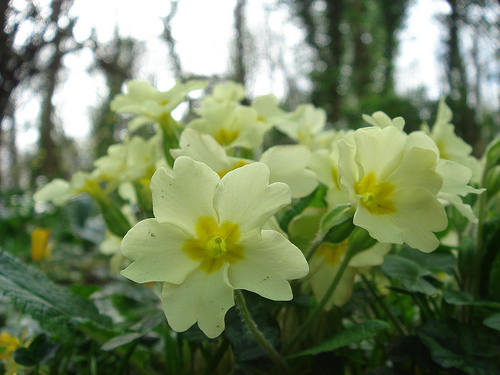Nutrition:
Primula obconica is similar to most plants and receives its main nutrients of carbon, hydrogen, and oxygen from the air and water. This way of acquiring "food" is known as photosynthesis. With its leaves increasing the surface area, light is usually very plentiful. During photosynthesis, the Poisonous Primrose absorbs the sunlight with the use of chlorophyll located in the chloroplasts on leaves.
PHOTOSYNTHESIS:

How it works:
- Light hits the chloroplast pigments.
- The light excites an electron and boosts
it to a high energy potential.
- In this excited energy state, electrons are
moved into a system where it stores energy
for later use.
- Even though the pigment lost its electron, it
receives another electron from water.
- The splitting of water results in the release
of oxygen through the open stomata.
- The next step is to use the stored up energy
to fix CO2 into
sugar (glucose).
Figure 1. Process of Photosynthesis
The above image is modified from Botany for
Gardeners: An Introduction and Guide.
The sugar (glucose) is then united with other sugar molecules to form starch. Starch is the principle food stored in plant cells. The sugar produced from photosynthesis travels down from the leaves to the rest of the plant by the vascular tissue called the phloem. Primary phloem is only formed during the first year; after the first year, this type of tissue become nonfunctional because secondary phloem is formed. Secondary phloem is not found in this plant because it only lives for one year. However, in other plants, secondary phloem is found near the center.
How does water get transferred in a plant?
Along with phloem, Primula obconica has the vascular tissue
xylem. Xylem has the same developmental process as phloem. It
first starts off as primary xylem, but then in the second year of
growth, it is replaced by secondary xylem. Secondary xylem is found near
the outside and aids in the distribution of water from the roots to
the tips of the leaves.
What's another organism that gets its food this way? Typha latifolia (the common cattail).
In gardens, the Poisonous Primrose has an abundance of minerals that the plant requires: nitrates, sulfates, calcium, iron, and phosphates. Other minerals that plants uses in less amounts include magnesium, copper, zinc, and molybdenum. In nature, plants get all these nutrients by the process of erosion releasing them into the soil. Mycorrhizal fungus aid in the process of nutrient uptake for most plants. In Primula obconica, mycorrhizal fungus works with the roots of the plant to penetrate into a greater volume of soil that the plant could not reach by itself. The fungus allows for the plant to receive more phosphorus and nitrogen (Capon, 1990).
![]()
Passing the Torch is the best
place to go next because it touches on the
reproduction of
Primula obconica.
Back to the home page.

